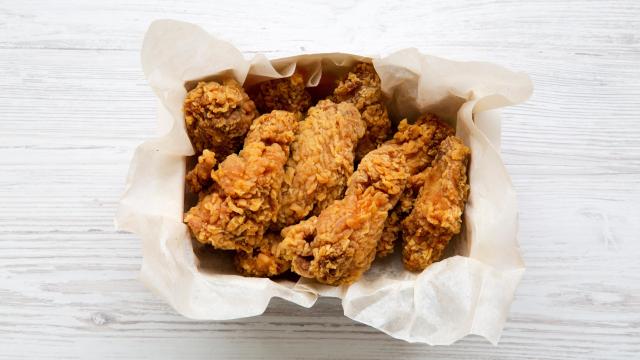Many foods can be fried to excellent results — pickles, potatoes, little nuggets of cheese — but nothing fries quite like chicken. When it’s at its best, fried chicken is hot and juicy on the inside and craggy and crunchy on the outside. It’s not hard to fry chicken, but it is time consuming, and it leaves a thin film of oil on every surface in your kitchen. If you’re going to put yourself through all that, you should do it correctly, and that starts with picking the right oil.
There is no single perfect chicken-frying oil. There are many good options to choose from, but a good chicken-frying fat has to meet three main criteria: It has to be cheap, it has to have a high smoke point, and it has to be flavourless.
Chicken frying oil should be cheap
Not only is expensive fried chicken antithetical to the very nature of the dish, but no one fries a small amount of chicken. If you’re going to fill your home with the aroma of frying oil, which is less pleasant than it sounds, you should get a satisfying (large) amount of fried chicken out of it.
A lot of chicken calls for a lot of oil, at least a quart or two, depending on the size of your chicken-frying pot. (And even then, you’ll still need to work in batches.) Don’t waste your money on fancy fats. Frying chicken in chicken schmaltz might sound tempting, but it’s prohibitively expensive (for most) and probably won’t taste all that great, which conveniently leads us to our next criteria…
Get an oil with a smoke point that’s higher than your frying temperature
One of the biggest fried food crimes one can commit is frying at too low of a temperature, which leads to soggy, sad bites — but frying in burnt oil is no better. For crunchy, crispy results, you want to keep your oil in between 325℉ and 350℉. That’s the goal, but depending on how deft you are at controlling the heat output of your stove burners, you may creep above or below those temps while you fry. Adding cold chicken to a hot oil will cause the temperature to drop each time, so you’ll have to fiddle with the knobs throughout the course of the cook to keep it hot (then readjust in the other direction to cool it down when you inevitably overcompensate).
Using an oil with a smoke point of 160°C (such as schmaltz) or 180°C (such as unrefined coconut oil) may seem like a fine idea — they fall within our range — but trying to keep your oil at exactly 160°C for schmaltz will result in soggy breading, and momentary creeps above 180°C when using unrefined coconut oil or the like can cause smoking, which can give your chicken a burnt, acrid flavour. Sidestep all of this nonsense and give yourself some wiggle room by grabbing an oil with a smoke point of 200°C or higher.
The less flavour, the better
I’m a big fan of using bougie, flavorful oils in the place of canola or vegetable in certain cases, like pistachio or olive oil in boxed mixes, but they have no place on fried chicken. Not only are these oils pricey, but those flavorful chemical compounds that make them so good won’t even make it through the high temps they’re about to encounter. They’ll burn off or just plain burn, giving your chicken an undesirable flavour.
What you want is a refined oil that’s been processed to remove anything that might smoke or burn at high temperatures. Vegetable oil, canola oil, lard, and vegetable shortening (Crisco) are all great candidates. Extra virgin olive oil is tricky, as its smoke point can range from 180°C to 210°C, but I wouldn’t use it anyway, due to its cost and flavour. (I don’t want my fried chicken to taste of olive oil.) Refined peanut oil is another good option. It has an appropriately high smoke point of 230°C, and doesn’t impart any peanut flavour, but it is a little more expensive than the others. (If that’s your favourite, get the most out of it by cleaning it with gelatin between batches.)
When in doubt, grab something cheap and utilitarian. Fried chicken was never meant to be fancy.

Leave a Reply
You must be logged in to post a comment.